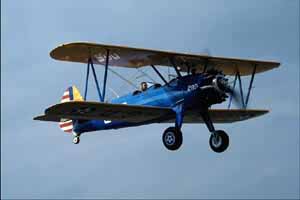Stearman PT-13 & PT-17 Kaydet
U.S. Primary Trainer
 |
One of the Ghost Squadron's Kaydets. Image source: The Confederate Air Force Ghost Squadron CD-ROM produced by Corel. Photos by Bill Crump. |
First ordered in 1937, the PT-13 was powered with a Lycoming radial engine of 215 hp, increased in later models to 225 hp. The open cockpit was thought to allow student pilots a better "feel" for flying, as they could sense changes in airflow on the sides of their faces if the aircraft were not keep straight or coordinated in turns.
Without radios or electric systems, these PTs were fitted with a simple one-way voice tube intercom system called a Gosport tube, through which the instructor could speak to the student, but the student could only listen.
Painted a bright chrome yellow and blue for high visibility, hundreds of these primary trainers filled the air at training bases all over the southern and western U.S. during the war. Trained pilots were often warned to stay clear of these "Yellow Perils"!
A change to a Continental engine of 220 hp resulted in a change in designation to PT-17, with first deliveries in 1940. This was the most produced version, with almost 3,000 built for the Army Air Corps and many more for the U.S. Navy as N2S trainers.
This Ghost Squadron aircraft was originally produced as a PT-17, as it is marked, but at some point a Lycoming engine was fitted to the airframe, making it appear like an earlier PT-13. Keeping 50 year old airplane flying requires a lot of time, sweat and money, and often a little bit of ingenuity!
Some of the Stearman design were built for the Royal Canadian Air Force as PT-27s, and a few were fitted with Jacobs R-755 radial engines for the Air Corp and called PT-18s.
Today, these classic biplanes still provide aviators old and new with the feel of the wind in their faces.
Specifications
Pilot and Passenger/Instructor One Lycoming R-680 Engine or One Continental R-670 Engine Max. Speed 135 mph @ sea level |
Climb to 10,000 ft in 17.3 minutes Length 24' 9" Max. Weight 2,635 lbs Normal Fuel 43 gallons Normal Range 505 miles |